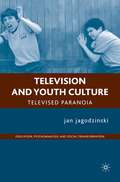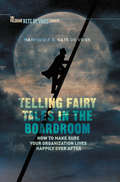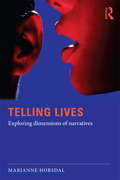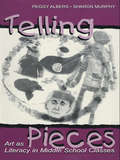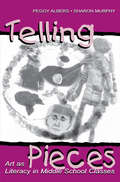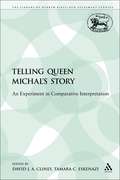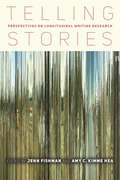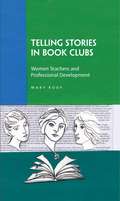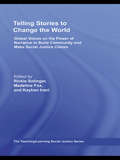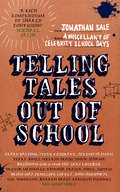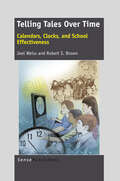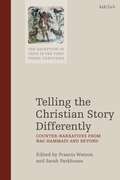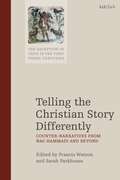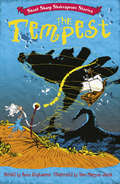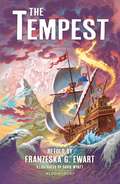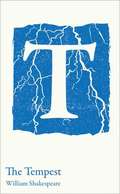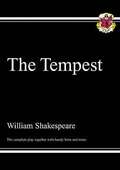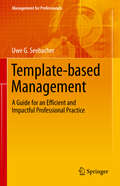- Table View
- List View
Telemental Health Care for Children and Families
by Larissa N. Niec Ciera E. SchoonoverThis book examines state-of-the-science telemental health interventions for children and families. It explores the adaptations necessary to provide remote formats of evidence-based models, such as parent-child interaction therapy and trauma-focused cognitive behavior therapy. Chapters provide clear descriptions of how to implement interventions in a telemental health format, a review and critique of the empirical evidence supporting them, and useful case studies. The volume addresses the use of telemental health care within parenting interventions, individual child interventions, and family interventions, with particular attention paid to the evidence base of efficacy for families from marginalized and underserved communities. Key topics covered include: Remote assessment of child cognitive functioning Parent-child interaction therapy (PCIT). Trauma-focused cognitive behavioral therapy (TF-CBT). Mom Power, for mothers with histories of substance use or trauma. Applied behavioral analysis for children with autism spectrum disorder (ASD). Cognitive behavioral therapy for children with anxiety. Telemental health with LGBTQ+ youth Telemental Health Care for Children and Families is an essential resource for clinicians, therapists, and all mental health professionals as well as researchers, professors, and graduate students across many interrelated disciplines, including developmental, clinical child, and school psychology, family studies, social work, child and adolescent psychiatry, psychotherapy, and pediatrics.
Television and Youth Culture: Televised Paranoia (Education, Psychoanalysis, and Social Transformation)
by J. jagodzinskiThis book explores youth in postmodern society through a Lacanian lens. Jagodzinski explores the generalized paranoia that pervades the landscape of television. Instead of dismissing paranoia as a negative development, he claims that youth today labour within the context of paranoia to find their identities.
Tell Along Tales!: Playing with Participation Stories
by Dianne de CasasThis book makes the perfect addition to teachers' and librarians' story time selections, containing 25 educational and entertaining tales from around the world as well as proven storytelling techniques.Storytelling predates reading. Storytelling is a vibrant tradition in nearly every culture on earth. And of course, storytelling serves as a perfect medium for educating young children and early readers.Specifically intended for elementary school and public librarians, teachers, storytellers, and camp counselors, Tell Along Tales!: Playing with Participation Stories contains 25 adapted tales from Czechoslovakia, Germany, Ireland, Korea, Norway, Spain, and West Africa that are appropriate for kindergarten through sixth grade students. These stories are linked to standards and are full of fun audience participation, making them perfect for the library, classroom, camp, or home. The book will illuminate the best methods for telling a tale, describe various types of audience participation and how to encourage it, identify elements in a story that provide opportunity for participation, explain when to include audience participation, and share the author's proven audience management techniques.
Telling Fairy Tales in the Boardroom: How to Make Sure Your Organization Lives Happily Ever After (INSEAD Business Press)
by Manfred F.R. Kets de VriesWe know where we are with a fairy story. There is a cast of predictable characters, the hero or heroine is submitted to terrible trials, cruelty, and injustice but in the end the baddies get their comeuppance, good triumphs, and everyone lives happily ever after. In this book Manfred Kets de Vries, one of the world's leading authorities on the psychology of leadership, and a pioneering practitioner in the field of psychodynamic executive coaching, draws on the format of traditional fairy tales and tells us five stories that dramatize five key themes of dysfunctional leadership. The accompanying commentaries analyze each tale and examine the ways in which it applies to leadership behavior and organizational practices. This diagnostic element is supported by self-assessment tests that reinforce the main lessons of each tale and guide the reader's interpretation of the results. With Kets de Vries's guidance you'll be able to help your clients create best places to work, where everyone is the best they can be, and lives 'happily ever after'.
Telling Lives: Exploring dimensions of narratives
by Marianne HorsdalBoth interest in and understanding of narrative analysis had developed rapidly in recent years and is now a mainstream element of research across many disciplines. In the groundbreaking Telling Lives: Exploring dimensions of narratives, the author illustrates as many facets as possible of the stories people tell about their lives. She demonstrates
Telling Lives: Exploring dimensions of narratives
by Marianne HorsdalBoth interest in and understanding of narrative analysis had developed rapidly in recent years and is now a mainstream element of research across many disciplines. In the groundbreaking Telling Lives: Exploring dimensions of narratives, the author illustrates as many facets as possible of the stories people tell about their lives. She demonstrates
Telling Pieces: Art As Literacy in Middle School Classes
by Peggy Albers Sharon MurphyTelling Pieces is an exploration of how pre-adolescent middle-school children develop a knowledge and understanding of the conventions of art (art as literacy) and how they use this knowledge to create representations of their lives in a small midwestern U.S. town. Beginning with an overview of social semiotics and emergent literacy theorizing, the authors set the stage for their study of sixth graders involved in art. A galleria of children's artworks is presented, allowing readers/viewers to consider these texts independent of the authors' interpretations of them. Then, set against the galleria is the story of the community and school contexts in which the artworks are produced--contexts in which racism, homophobia, and the repression of creativity are often the norm. The interpretation the authors bring to bear on the artworks reveals stories that the artworks may or may not tell on their own. But the tales of artistic literacy achievement are counterbalanced by reflection about the content of the artworks produced, because the artworks reveal the impossibility for students to imagine beyond the situational bounds of racism, homophobia, and religiosity. The authors conclude by raising questions about the kinds of conditions that make literacy in art possible. In doing so, they explore selected alternative models and, in addition, ask readers to consider the implications of the ideological issues underlying teaching children how to represent their ideas. They also advocate for a participatory pedagogy of possibility founded on ethical relational principles in the creation and interpretation of visual text. Of particular interest to school professionals, researchers, and graduate students in literacy or art education, this pioneering book: * brings together the fields of art education and literacy education through its focus on how middle school students come to work with and understand the semiotic systems, * introduces sociolinguistic, sociological, and postmodernist perspectives to thinking about children's work with art--adding a new dimension to the psychological and developmental descriptions that have tended to dominate thinking in the field, * includes a galleria of 40 examples of children's artwork, providing a unique opportunity for readers/viewers to interpret and consider the artwork of the sixth graders independent of the authors' interpretations, * presents descriptions of art teaching in process, * gives considerable attention to the interpretation of the children's artworks and the influences that contribute to the content they represent, and * considers varying models of art education along with the implications of introducing new representational possibilities.
Telling Pieces: Art As Literacy in Middle School Classes
by Peggy Albers Sharon MurphyTelling Pieces is an exploration of how pre-adolescent middle-school children develop a knowledge and understanding of the conventions of art (art as literacy) and how they use this knowledge to create representations of their lives in a small midwestern U.S. town. Beginning with an overview of social semiotics and emergent literacy theorizing, the authors set the stage for their study of sixth graders involved in art. A galleria of children's artworks is presented, allowing readers/viewers to consider these texts independent of the authors' interpretations of them. Then, set against the galleria is the story of the community and school contexts in which the artworks are produced--contexts in which racism, homophobia, and the repression of creativity are often the norm. The interpretation the authors bring to bear on the artworks reveals stories that the artworks may or may not tell on their own. But the tales of artistic literacy achievement are counterbalanced by reflection about the content of the artworks produced, because the artworks reveal the impossibility for students to imagine beyond the situational bounds of racism, homophobia, and religiosity. The authors conclude by raising questions about the kinds of conditions that make literacy in art possible. In doing so, they explore selected alternative models and, in addition, ask readers to consider the implications of the ideological issues underlying teaching children how to represent their ideas. They also advocate for a participatory pedagogy of possibility founded on ethical relational principles in the creation and interpretation of visual text. Of particular interest to school professionals, researchers, and graduate students in literacy or art education, this pioneering book: * brings together the fields of art education and literacy education through its focus on how middle school students come to work with and understand the semiotic systems, * introduces sociolinguistic, sociological, and postmodernist perspectives to thinking about children's work with art--adding a new dimension to the psychological and developmental descriptions that have tended to dominate thinking in the field, * includes a galleria of 40 examples of children's artwork, providing a unique opportunity for readers/viewers to interpret and consider the artwork of the sixth graders independent of the authors' interpretations, * presents descriptions of art teaching in process, * gives considerable attention to the interpretation of the children's artworks and the influences that contribute to the content they represent, and * considers varying models of art education along with the implications of introducing new representational possibilities.
Telling Queen Michal's Story: An Experiment in Comparative Interpretation (The Library of Hebrew Bible/Old Testament Studies)
by David J. Clines Tamara C. EskenaziThis book, an anthology of previously published writing about Michal together with some new and original essays, is something of an experiment. Its purpose is to provide reders with raw materials for developing their own reading of the Michal story. It does not offer a unified portrait of this biblical character, but rather invites readers to form their own assessment interactively with these readings of the Michal story. At the same time, this book presents some systematic guidance for coping with these divergent interpretations of the complex and tantalizing figure of Michal.
Telling Stories: Perspectives on Longitudinal Writing Research
by Jenn Fishman Amy Kimme HeaIn Telling Stories, more than a dozen longitudinal writing researchers look beyond conventional project findings to story their work and, in doing so, offer otherwise unavailable glimpses into the logics and logistics of long-range studies of writing. The result is a volume that centers interrelations among people, places, and politics across two decades of praxis and an array of educational sites: two-year colleges, a senior military college, an adult literacy center, a small liberal arts college, and both public and private four-year universities. Contributors share direct knowledge of longitudinal writing research, citing project data (e.g., interview transcripts, research notes, and journals), descriptions drawn from memory, and extended personal reflections. The resulting stories, tempered by the research and scholarship of others, convey a sense of longitudinal research as a lived activity as well as a prominent and consequential approach to inquiry. Yet Telling Stories is not a how-to guide, nor is it written for longitudinal researchers alone. Instead, this volume addresses issues about writing research that are germane to all who conduct or count on it. Such topics include building and sustaining good interpersonal research relations, ethically negotiating the institutional power dynamics that undergird writing research, effectively using knowledge from longitudinal studies to advocate for writers and writing educators, and improving both conceptual and concrete resources for long-range research in writing studies.
Telling Stories in Book Clubs: Women Teachers and Professional Development
by Mary KooyThis book examines questions in the intersections of narrative, teaching, communities of learning, knowledge, women teachers and teacher development. Stories constitute the heart of this book and the glue that holds the pieces together. This book explores the ways women educators understand and make sense of their lives and develop their personal practical knowledge of teaching through narrative texts and experiences in informal learning groups.
Telling Stories to Change the World: Global Voices on the Power of Narrative to Build Community and Make Social Justice Claims (Teaching/Learning Social Justice)
by Rickie Solinger Madeline Fox Kayhan IraniTelling Stories to Change the World is a powerful collection of essays about community-based and interest-based projects where storytelling is used as a strategy for speaking out for justice. Contributors from locations across the globe—including Uganda, Darfur, China, Afghanistan, South Africa, New Orleans, and Chicago—describe grassroots projects in which communities use narrative as a way of exploring what a more just society might look like and what civic engagement means. These compelling accounts of resistance, hope, and vision showcase the power of the storytelling form to generate critique and collective action. Together, these projects demonstrate the contemporary power of stories to stimulate engagement, active citizenship, the pride of identity, and the humility of human connectedness.
Telling Stories to Change the World: Global Voices on the Power of Narrative to Build Community and Make Social Justice Claims (Teaching/Learning Social Justice)
by Rickie Solinger Madeline Fox Kayhan IraniTelling Stories to Change the World is a powerful collection of essays about community-based and interest-based projects where storytelling is used as a strategy for speaking out for justice. Contributors from locations across the globe—including Uganda, Darfur, China, Afghanistan, South Africa, New Orleans, and Chicago—describe grassroots projects in which communities use narrative as a way of exploring what a more just society might look like and what civic engagement means. These compelling accounts of resistance, hope, and vision showcase the power of the storytelling form to generate critique and collective action. Together, these projects demonstrate the contemporary power of stories to stimulate engagement, active citizenship, the pride of identity, and the humility of human connectedness.
Telling Tales Out of School: A Miscellany of Celebrity School Days
by Jonathan SaleWHICH UNIVERSITY CHALLENGE PRESENTER FAILED HIS ELEMENTARY MATHS O LEVEL SIX TIMES? FOR WHICH DRAGONS' DEN INVESTOR WAS FLOGGING LEATHER JACKETS A LUNCH BREAK ACTIVITY? WHICH ENVIRONMENTALIST WAS EXPELLED AT PRIMARY SCHOOL FOR ATTEMPTING TO POISON HIS CLASSMATES WITH DEADLY NIGHTSHADE? WHICH ADVENTURER AND EXPLORER SPENT HIS TIME AT ETON SHINNING UP THE ARCHITECTURE? Through intimate conversations with journalist Jonathan Sale, some of Britain's leading personalities reminisce about their school and college days, revealing the portents, paths and false starts that led them to where they are today. With poignant and hilarious anecdotes spanning everything from those very first days at school to receiving their dreaded O level, A level and degree results, this book is brimming with recollections that every reader can associate with. Tributes are paid to the teachers who opened doors, whilst others tell tales on those who slammed them in their faces. And all credit to the teachers who were truly prophetic about their pupils. These personalities may be reticent with regard to their adult personal lives, but speak candidly about their childhoods, revealing fascinating insights into the role their formative years played in shaping them to become the people they are today.
Telling Tales Over Time: Calendars, Clocks, and School Effectiveness
by Joel Weiss Robert S. BrownHow do calendars and clocks influence considerations of school effectiveness? From the creation of compulsory education to the future of virtual schooling, Weiss and Brown trace two centuries of school practices, policies and research linking the concept of time with ‘opportunity to learn’. School calendars and clocks are shaped by both the physical and social worlds, and the ‘clock of schooling’ is shown to be one of the ‘great clocks of society’ that helps to frame school effectiveness. School time does not operate in a vacuum, but within curriculum, teaching and learning situations. The phrase ‘chrono-curriculum’ was devised by the authors as a metaphor for exploring issues of school effectiveness within the time dimension. Using American and Canadian sources, stories are created to illustrate four themes about time and school effectiveness. The first three stories utilize access, attendance and testing as criteria associated with these eras of schooling. How will the story read in the fourth era, the digital age, which forces us to a reconsideration of time and its influence on education? Quoting David Berliner in his Foreword: “ this is an opportune time for these authors to bring us insights into the reasons we in North America created our public school systems, and how the chrono-curriculum influences those systems. The authors’ presentation of our educational past provides educators a chance to think anew about how we might do schooling in our own times.”
Telling the Christian Story Differently: Counter-Narratives from Nag Hammadi and Beyond (The Reception of Jesus in the First Three Centuries)
by Francis Watson Sarah ParkhouseThis volume examines the 'counter-narratives' of the core Christian story, proposed by texts from Nag Hammadi and elsewhere. A noteworthy body of highly respected scholars examine material that is sometimes difficult and often overlooked, contributing to the ongoing effort to integrate Nag Hammadi and related literature into the mainstream of New Testament and early Christian studies. By retracing the major elements of the Christian story in sequence, they are able to discuss how and why each aspect was disputed on inner-Christian grounds, and to reflect on the different accounts of Christian identity underlying these disputes. Together the essays in this book address a central issue: towards the end of the second century, Irenaeus could claim that the overwhelming majority of Christians throughout the world were agreed on a version of the core Christian story which is still recognisable today. Yet, as Irenaeus concedes and as the Nag Hammadi texts have confirmed, there were many who wished to tell the core Christian story differently. Those who criticized and rejected the standard story did so not because they were adherents of another religion, 'Gnosticism', but because they were Christians who believed that the standard account was wrong at point after point. Ranging from the Gospels of Judas and Mary to Galatians and Ptolemy's Letter to Flora, this volume provides a fascinating analysis of how the Christian story as we know it today developed against counter-readings from other early Christian traditions.
Telling the Christian Story Differently: Counter-Narratives from Nag Hammadi and Beyond (The Reception of Jesus in the First Three Centuries)
by Francis Watson Sarah ParkhouseThis volume examines the 'counter-narratives' of the core Christian story, proposed by texts from Nag Hammadi and elsewhere. A noteworthy body of highly respected scholars examine material that is sometimes difficult and often overlooked, contributing to the ongoing effort to integrate Nag Hammadi and related literature into the mainstream of New Testament and early Christian studies. By retracing the major elements of the Christian story in sequence, they are able to discuss how and why each aspect was disputed on inner-Christian grounds, and to reflect on the different accounts of Christian identity underlying these disputes. Together the essays in this book address a central issue: towards the end of the second century, Irenaeus could claim that the overwhelming majority of Christians throughout the world were agreed on a version of the core Christian story which is still recognisable today. Yet, as Irenaeus concedes and as the Nag Hammadi texts have confirmed, there were many who wished to tell the core Christian story differently. Those who criticized and rejected the standard story did so not because they were adherents of another religion, 'Gnosticism', but because they were Christians who believed that the standard account was wrong at point after point. Ranging from the Gospels of Judas and Mary to Galatians and Ptolemy's Letter to Flora, this volume provides a fascinating analysis of how the Christian story as we know it today developed against counter-readings from other early Christian traditions.
Telling the Time Activity Book for Ages 5-7
by Cgp BooksA fun, colourful Activity Book packed with charming characters and engaging activities. It's ideal for introducing your child to telling the time, and learning about the days, weeks and months of the year! We've explained everything in easy-to-understand language with loads of colourful diagrams - your child will be time-wiz before you know it! Each topic is covered by a range of activities - all designed to help that time-telling knowledge really stick. We’ve also thrown in a selection of exciting puzzles so your child can apply their Maths skills in a different context. Answers can be found at the back of the book.
Telugu Baasha Charitra, M.A. Previous Telugu, Paper-I, SDE AU
by Acharya Balagangadhar Rao Acharya H.S.Brahmanandam Acharya Lakamsani Chakradhararao Acharya Nethi Anantarao Shastri Acharya P. Rajeswari Acharya P.Narasimha Reddy Acharya Parvataneni Subbarao Acharya Peta Srinivas ReddyThis is the prescribed textbook to the students of MA Previous Telugu for the subject Telugu Baasha Charitra, at School of Distance education, Andhra University
The Tempest: The Tempest (ebook) (Short, Sharp Shakespeare Stories #4)
by Anna ClaybourneA powerful storm, a dramatic shipwreck, an enchanted island, a sorcerer's daughter and a handsome prince... Discover the magical story at the heart of The Tempest, one of Shakespeare's best-loved plays. The age-appropriate text in Short, Sharp Shakespeare Stories: The Tempest introduces readers to the play by re-telling the story in modern English, making it an ideal introduction to Shakespeare for children of 9 and above. The book also contains information about the background to The Tempest, its major themes, language, and Shakespeare's life during the time he was writing the play, so is a useful resource for project work, or for anyone studying the play itself.Magic, and its meaning in 16th century England, are also examined, to give the play a factual grounding.Anna Claybourne's concise, witty text really brings out the humour and the drama of the stories, rendering them as relevant today as they were in Shakespeare's time. Comparisons with themes in modern life: love, revenge, family relationships, political power struggles, etc., serve to reinforce this.The text is supported by Tom Morgan-Jones' fantastic artwork, giving the series real visual appeal. Short, Sharp Shakespeare Stories allow children today to be as enthralled by Shakespeare's tales as audiences were 400 years ago. Other titles in the series include Macbeth, A Midsummer Night's Dream, Romeo and Juliet, Much Ado About Nothing and Hamlet.
The Tempest: A Bloomsbury Reader (Bloomsbury Readers)
by Franzeska G. EwartA vibrant retelling of Shakespeare's The Tempest told through the voice of Ariel, written by Franzeska G. Ewart.A year has passed since Ariel's storm brought a shipwreck to the magical island. Now freed from slavery, Ariel returns to the island and remembers the events of that fateful day. The day that love blossomed, fools were exposed, and traitors were brought to justice. Franzeska G. Ewart's imaginative recreation of The Tempest by William Shakespeare has beautiful black-and-white illustrations by David Wyatt and is perfect for children who are developing as readers.The Bloomsbury Readers series is packed with brilliant books to get children reading independently in Key Stage 2, with book-banded stories by award-winning authors like double Carnegie Medal winner Geraldine McCaughrean and Waterstones Prize winner Patrice Lawrence covering a wide range of genres and topics. With charming illustrations, ideas for discussion points and online guided reading notes written by the Centre for Literacy in Primary Education (CLPE), this series is ideal for reading both in the classroom and at home. For more information visit www.bloomsburyguidedreading.com.'Patrice Lawrence, Tony Bradman, Margaret Mahy [...] any list that brings together such a quality line up of authors is going to be welcomed.' - Books for Keeps on the seriesBook Band: Dark Red (Ideal for ages 10+)
The Tempest: A Bloomsbury Reader (Bloomsbury Readers)
by Franzeska G. EwartA vibrant retelling of Shakespeare's The Tempest told through the voice of Ariel, written by Franzeska G. Ewart.A year has passed since Ariel's storm brought a shipwreck to the magical island. Now freed from slavery, Ariel returns to the island and remembers the events of that fateful day. The day that love blossomed, fools were exposed, and traitors were brought to justice. Franzeska G. Ewart's imaginative recreation of The Tempest by William Shakespeare has beautiful black-and-white illustrations by David Wyatt and is perfect for children who are developing as readers.The Bloomsbury Readers series is packed with brilliant books to get children reading independently in Key Stage 2, with book-banded stories by award-winning authors like double Carnegie Medal winner Geraldine McCaughrean and Waterstones Prize winner Patrice Lawrence covering a wide range of genres and topics. With charming illustrations, ideas for discussion points and online guided reading notes written by the Centre for Literacy in Primary Education (CLPE), this series is ideal for reading both in the classroom and at home. For more information visit www.bloomsburyguidedreading.com.'Patrice Lawrence, Tony Bradman, Margaret Mahy [...] any list that brings together such a quality line up of authors is going to be welcomed.' - Books for Keeps on the seriesBook Band: Dark Red (Ideal for ages 10+)
The Tempest (Collins Classroom Classics) (PDF)
by William Shakespeare Peter Alexander Lucy Toop Mike GouldExam board: AQA, Edexcel; CXC Level & Subject: GCSE 9-1 English Literature; CSEC® English B First teaching: September 2015 First examination: June 2017 This edition of The Tempest is perfect for GCSE-level students, with the complete play in an accessible format, on-page notes, introduction setting the context, timeline, character and theme indexes.
The Tempest - The Complete Play with Annotations, Audio and Knowledge Organisers
by Shakespeare William"This The Tempest Complete Play contains the full text of all five acts, with helpful annotations explaining all the tricky bits in plain English. It includes scene overviews and a context section, so that students can keep track of the plot, characters and historical details. Plus, there is lots of practice, with questions and activities at the end of every scene. We've also added Knowledge Organiser pages, which lay all the essentials out in one handy place, and online audio extracts, which let students hear key scenes performed, just as Shakespeare intended. "
Template-based Management: A Guide for an Efficient and Impactful Professional Practice (Management for Professionals)
by Uwe G. SeebacherThe Template-based management (TBM) approach has been used since 2003 across the world in diverse contexts. It has evolved hand-in-hand with the evolution of business: Agile, Blueprints, Canvas, Design Thinking, or Kanban are only few of the many current concepts based on the approach. This book expands and upgrades the author's 2003 book 'Template-driven Consulting' (Springer) by tracing this evolution and offering the current state-of-the-art to practitioners. TBM combines structure and method: pre-structuring diverse processes, it helps to present complex activities and procedures in a simple, clear, and transparent manner and then implement them. The use of TBM ranges from conception or creative work in agencies to designing organizations and strategies, planning and monitoring initiatives and projects, to innovation management and optimizing cost structures, processes, or entire departments and divisions. The book also demonstrates how successful organizations use TBM to methodically and structurally apply the internal know-how in a cost and time-optimal way for attaining sustainable business success. Readers will learn to apply and use TBM, identify its importance, and benefit from a variety of case studies that illustrate the application and use for the entire business and management practice.

